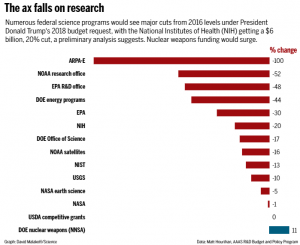Mar 20 2017
The Need for Publicly Funded Science
 The American scientific community is in a bit of a panic over Trump’s first proposed budget. The budget calls for an 18% decrease ($5.8 billion) for the National Institutes of Health (NIH). There are deep cuts in energy research and Earth science as well.
The American scientific community is in a bit of a panic over Trump’s first proposed budget. The budget calls for an 18% decrease ($5.8 billion) for the National Institutes of Health (NIH). There are deep cuts in energy research and Earth science as well.
The reaction of the scientific community has been consistent – such cuts would be disastrous.
It probably comes as no surprise that science is expensive. This is despite the fact that scientists are generally paid very little, especially when compared to their years of training. Science is a career of passion. But maintaining a lab or conductive field research can be very expensive. Research often requires expensive equipment and materials, lab space, support staff, and lots of time.
Research is not just something that scientists do – it requires extensive infrastructure. That infrastructure needs to be maintained mostly with one-off grants. The vast majority of scientific research will not directly generate profits for the researchers, the lab, or the supporting institution. Keeping a lab going is like keeping plates spinning, the researchers are constantly applying for grants and weaving together the funding they need.
You might think that an institution can support a lab through lean times, but this is rarely the case. In fact, the money flows the other way. Labs support their institutions by giving them a percentage of their grants (usually around 30%). This pays for the basic overhead, like keeping the lights on, maintaining an institutional review board, shared administrative staff, and rent on the space.
In order to maintain funding scientists have to demonstrate the value of their work and that they are making progress by regularly publishing their results.
Funding is like water in the desert, life will bloom wherever there is water, and will wilt and die without it.
A sudden and dramatic cut in funding, such as an 18% decrease for the NIH, is a disaster for our biomedical research infrastructure. Some analysts say that this cut will essentially mean no new grants awarded in 2018, as the remaining budget is already earmarked for funding existing grants. This means that a lot of plates will start to fall.
Scientists cannot easily reduce their costs by 20%, or survive through a year without new NIH grants. New scientists may not be able to start their career, and are likely to disproportionately suffer from such a decrease. Labs may have to fire technicians, abandon ongoing research, or even close completely.
Think about it this way – money for research is like food. You need a reliable supply of it. You can’t just average out how much food you have access to over a year, you need food every single day. Any significant disruption in the food supply causes famine, with resulting sickness and even death. Trump’s budget would cause a science-funding famine with long term damage to our research infrastructure. Even if you think (for some reason) that we need to tighten our scientific research belts, you don’t diet by not eating for a few months.
Not only that, but scientific knowledge is like a delicate chain of individual and institutional memory that requires continuity. The Soviets famously gutted their genetics research infrastructure when they supported Lysenkoism for ideological reasons. Russian genetics has never recovered, and still lags to this day. Why do certain countries lead for decades in some research areas? Because they are maintaining an infrastructure and continuity of knowledge and skills that cannot be easily replicated.
Some may argue that scientific research is better funded by the private sector. In fact, private sector scientific research has increased from 40% in 1960 to 65% today. Privately funded research is a good thing, but it does not replace publicly funded research. Each has its own strengths and weaknesses, and one does not replace the other.
Private research is good for translational research, taking scientific knowledge that final step to a specific application. Companies, of course, want to make a profit from such research. They need to develop a product.
Even charitable organizations, however, often want to fund research with tangible results, like curing a disease. This may distort the research in a bad way, however. Remember, life follows the water. This kind of funding shifts the balance of research from basic science to translational research. This balance, however, needs to evolve organically. If you put your thumb on the scale you will likely end up wasting a lot of time and resources trying to discover something that we are just not ready to discover, meaning that we lack the basic science knowledge to translate.
Goal-oriented research has its purpose, but it depends a great deal on basic research that just follows the ideas of scientists trying to understand how things work. We cannot really predict which basic science discoveries will translate into specific applications.
Shifting the focus too much to applied science is like eating your seed corn. We may see a pulse of applications emerge, but then the well of basic science will dry up and overall scientific advance will slow.
If something like Trump’s budget gets passed, there will be immediate negative consequences for the scientific infrastructure in the US that will have negative effects for years, and even decades. The worst effects, however, may not be felt for decades, as that is the time scale of reaping the benefits of basic science.
America’s dominant economic position in the world is based largely on our robust support for scientific research and advance. I’m not sure how gutting our scientific infrastructure is supposed to make American great.






